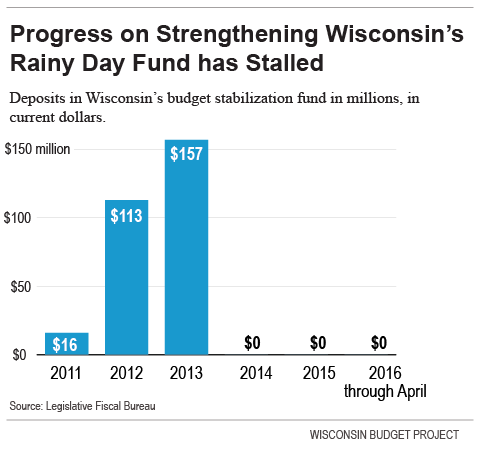Slow Progress on State Rainy Day Fund
Walker administration made some contributions but fund is still tiny.
Regularly putting money into the state’s Rainy Day Fund during periods of sustained economic growth helps build up a budget cushion on which the state can rely to cushion the impact of recessions and avoid harmful budget cuts. But before 2011, Wisconsin’s Rainy Day Fund sat mostly empty.
In 2011, 2012, and 2013, the state deposited money into the Rainy Day Fund when tax revenues came in higher than anticipated, building the balance to $280 million. But lawmakers made no deposits to the fund in 2014, 2015, or in 2016 so far. They pushed aside a requirement that part of higher-than-anticipated tax revenues be deposited in the Rainy Day Fund, and instead passed new tax cuts and allowed existing tax cuts to grow. Some of those tax breaks benefited large corporations and taxpayers with high incomes.
There’s no hard-and-fast rule about how big a state’s Rainy Day Fund should be, but the Government Finance Officers Association recommends that states have at a minimum of 5% to 15% of annual general revenues set aside. Wisconsin has set aside less than 2% of annual revenues, meaning our Rainy Day Fund is less than half the minimum recommended size. That will limit our options for avoiding tax increases or damaging spending cuts in the future.
After a promising start, Wisconsin’s progress in building up the Rainy Day Fund has taken a back seat to other priorities. Lawmakers will need to get back on track if we are to make sure that we have enough money in the fund to weather future economic storms.
Wisconsin Budget
-
Charting The Racial Disparities In State’s Prisons
 Nov 28th, 2021 by Tamarine Cornelius
Nov 28th, 2021 by Tamarine Cornelius
-
State’s $1 Billion Tax Cut Leaves Out 49% of Taxpayers
 Sep 21st, 2021 by Tamarine Cornelius
Sep 21st, 2021 by Tamarine Cornelius
-
TANF Program Serves a Fraction of Poor Families
 Aug 30th, 2021 by Jon Peacock
Aug 30th, 2021 by Jon Peacock






















